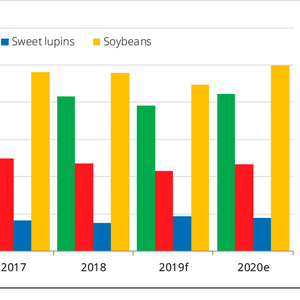Estimates suggest European soybean planting up 11% year-on-year

May 14, 2020
BY UFOP
The area in the EU-27 planted with legumes for the 2020 crop will presumably be up 9 percent at 2.5 million metric tons. Soybeans account for the largest hectarage and see the biggest increase in area relative to other legume crops. According to information published by the EU Commission, soybeans occupy an area of just about 1 million hectares in 2020, which is up 11 percent year-on-year. Italy is the biggest soybean producer in the European community, followed by France and Romania.
The commission also expects significant area expansions in field beans and feed peas. Farmers in the EU-27 are estimated to have sown 470,000 hectares with field beans, which translates to a 9 percent rise from 2019. The land dedicated to feed pea production is seen to have expanded 8 percent to 840,000 hectares. In contrast, the sweet lupin area will presumably decline 3 percent to 180,000 hectares.
Because of the increase in legume area, the EU Commission expects a total legume harvest of 6.7 million tons, up 10 percent from the previous year. According to investigations conducted by Agrarmarkt Informations-Gesellschaft (mbH), production of field beans and soybeans is likely to rise 12 percent each. Soybean output would hit a record high of 2.95 million tons. Whereas feed pea production is projected to grow 8 percent to 2.2 million tons, sweet lupins are expected to decrease around 2 percent to 260,000 tons.
Advertisement
The Union zur Förderung von Oel- und Proteinpflanzen e.V. (UFOP) has welcomed the development in crop production as a beneficial contribution towards greater diversity in crop rotation systems. At the same time, the association has drawn attention to a current initiative of Copa-Cogeca, the confederation of the Committee of Professional Agricultural Organisations and the European General Confederation of Agricultural Cooperatives. In view of the current coronavirus crisis and the EU’s continued strong reliance on imports of soybeans and rapeseed, Copa-Cogeca has called on the EU Commission to suspend the restrictions on the use of crop protection products for nitrogen-fixing crops grown on ecological priority areas to boost production of soybeans, peas, beans and lupins in the EU.
UFOP has also warned that a decline in production of biofuels made from sustainably produced European feedstock crops such as rapeseed would lead to a lower European supply of protein-rich GM-free joint products.
Advertisement
Related Stories
The USDA significantly increased its estimate for 2025-’26 soybean oil use in biofuel production in its latest World Agricultural Supply and Demand Estimates report, released July 11. The outlook for soybean production was revised down.
U.S. fuel ethanol capacity fell slightly in April, while biodiesel and renewable diesel capacity held steady, according to data released by the U.S. EIA on June 30. Feedstock consumption was down when compared to the previous month.
The U.S. EPA on July 8 hosted virtual public hearing to gather input on the agency’s recently released proposed rule to set 2026 and 2027 RFS RVOs. Members of the biofuel industry were among those to offer testimony during the event.
The USDA’s Risk Management Agency is implementing multiple changes to the Camelina pilot insurance program for the 2026 and succeeding crop years. The changes will expand coverage options and provide greater flexibility for producers.
The USDA’s National Agricultural Statistics Service on June 30 released its annual Acreage report, estimating that 83.4 million acres of soybeans have been planted in the U.S. this year, down 4% when compared to 2024.
Upcoming Events










